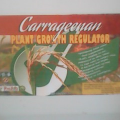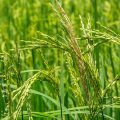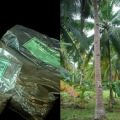Carrageenan plant growth regulator (CPGR) has recently been found to increase rice yield by more than 65%.

In a multi-location project, the trial conducted in Bulacan by the team led by Dr. Gil L. Magsino of the National Crop Protection Center – University of the Philippines-Los Banos (UPLB-NCPC), yielded the following results: On grain weight, application of 3 and 6 bags of chemical fertilizer per hectare (ha), combined with 200 ppm (or 20 mL/L) of CPGR yielded higher grain weight (450 g and 455 g/10 hills, respectively) than the farmers’ practice of applying 9 bags of chemical fertilizer/ha, which yielded only 275 g/10 hills.
Productive tillers and panicle length (length of inflorescence) were also significantly higher in the test crops compared with those in the farmers’ field. Productive tillers are the rice stems that bear panicles (rice inflorescence) with fertilized grains, while longer rice panicle is associated with producing more rice grains.
Carrageenan is an indigestible polysaccharide (carbohydrate) extracted from edible seaweeds. It is mainly used as thickener or stabilizer in the food industry or as a binding agent for domestic products such as toothpaste and shampoo, and in many biotechnology and pharmaceutical products. Results of studies conducted by the Philippine Nuclear Research Institute of the Department of Science and Technology (DOST-PNRI) showed that when polysaccharide is subjected to modified irradiation technology can be an effective growth promoter. At a very small dose, CPGR is an effective organic fertilizer. Researchers from UPLB-NCPC also found CPGR as inducer of resistance against rice’s major pests.
CPGR offers an array of benefits, e.g., it makes the rice stem stronger thus, improves rice resistance to lodging; it is compatible with farmers’ practice on fertilizer application thus, giving higher grain yield potential; it promotes resistance to rice tungro virus and bacterial leaf blight. Moreover, it has no harmful effects on natural enemies or beneficial insects and arthropods and thus environment-friendly.
This collaborative program implemented by the DOST-PNRI, Philippine Rice Research Institute (PhilRice), and UPLB-NCPC is being funded by the Philippine Council for Agriculture, Aquatic and Natural Resources Research and Development of the DOST (DOST-PCAARRD).
By
Marita A. Carlos, DOST-PCAARRD S&T Media Service






